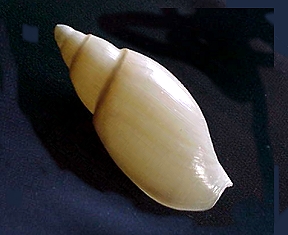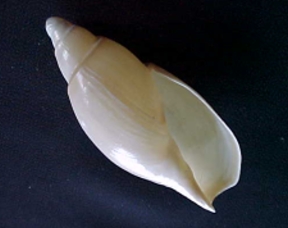|
Provocator pulcher (Watson, 1882)
|
|
 
|
|
Class: Gastropoda
Family: Volutidae
Species: Provocator
pulcher (Watson, 1882)
English Name: None.
Locality: Near the Kerguelen
Islands.
Image: Sony Mavica digital camera.
|
| .....The shells of the Volutes are amongst the most beautiful
and popular families of molluscs. Volutes are usually larger than average,
as shells go, and come in a variety of graceful shapes, often with splendid
patterns and wonderful colors. The variation of form, pattern and color
within a given species or population, is also often extremely variable,
and one species may have numerous forms, each of which can only be found
in a very limited geographic area. The species illustrated shows the gracefulness
of the family, but not the colors - as detailed below. |
| .....Volutes are carnivorous - all of them eat only meat for a living.
They often drill into their prey, using their file-like "radula" to create
holes in the shells of other molluscs, which they often feed on. Other
species engulf their prey whole and digest them at leisure. // Volutes
are "direct" develpers: instead of having a "veliger" or free-swimming
life phase, they grow to a rather large size inside their egg, which is
why they often have such a large "protoconch", which is the portion of
the shell which grows inside the egg, before the animal hatches out. As
a result of this, many species and forms of Volute have an extremely limited
range - some are only found around a single island!! This is because there
is very limited exchange of genetic material between populations when
the animals do not travel very far either in their juvenile or their adult
life-stages. |
| .....Provocator pulcher (Watson) is an excellent example of a species
which occurs in a very limited geographic range - it is found only in
the waters near the Kerguelen Islands, which are a French possession in
the sub-arctic region of the Indian ocean, some 6000 miles (nearly 10,000
km!) south of the tip of India - very isolated, so the species has develped
and remains in this small area. It also illustrates very well what happens
to even very colorful and well-patterned families of Mollusc when they
live at great depths in the ocean - usually around 1 km straight down
in the case of P. pulcher: they become thin-shelled and lose their
patterns and colors!! |
| .....This species is a great rarity in private collections,
since it is acquired only through the occasional research trip which produces
excess specimens which someone subsequently sells upon the private market.
Nevertheless, in nature it is quite common in its preferred habitat, as
are the famed "slit shells" (Pleurotomariidae) which also occur most often
at great depths and are thus seldom caught in the nets of fishermen, yet
nevertheless include some of the most abundant species of mollusc on the
planet. |
|

